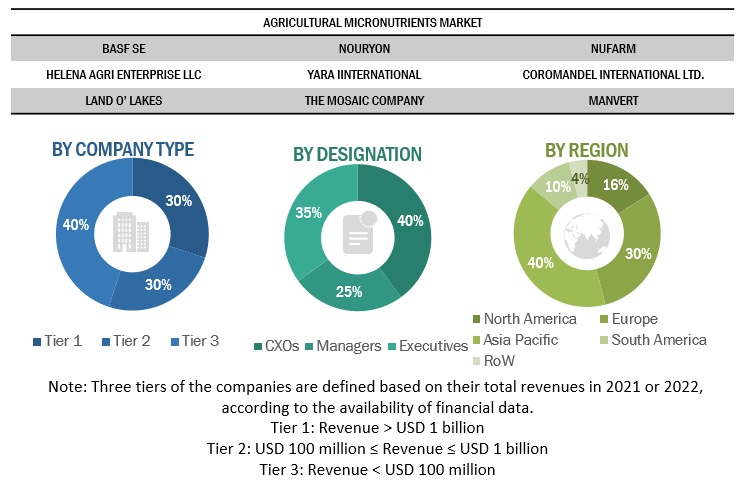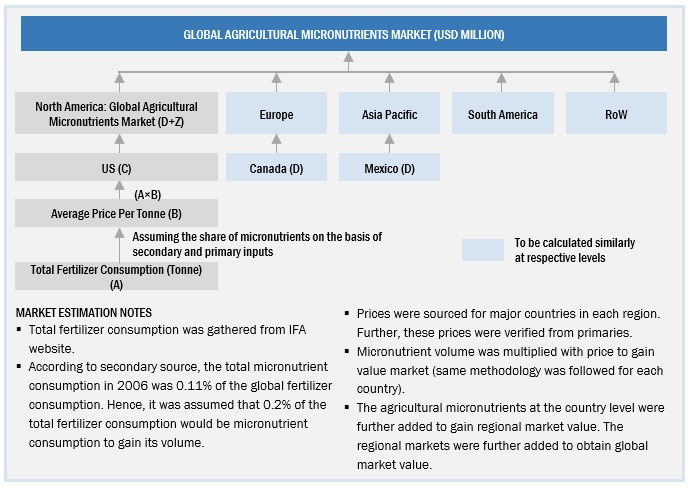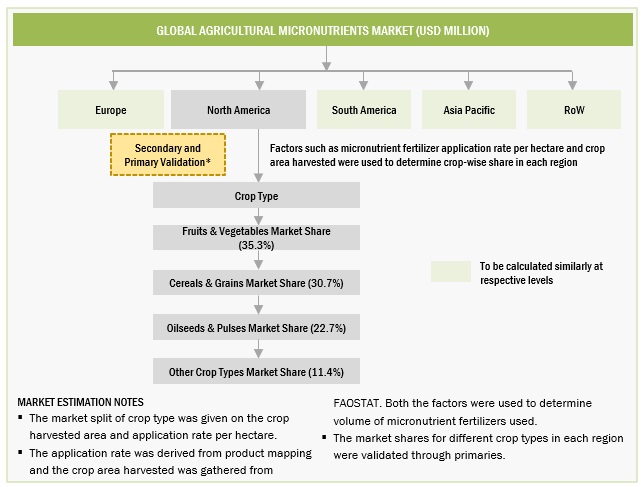This research study involved the extensive use of secondary sources—directories and databases such as Bloomberg Businessweek and Factiva—to identify and collect information useful for a technical, market-oriented, and commercial study of the agricultural micronutrient market. In-depth interviews were conducted with various primary respondents—such as key industry participants, subject matter experts (SMEs), C-level executives of key market players, and industry consultants—to obtain and verify critical qualitative and quantitative information as well as to assess prospects.
Secondary Research
The secondary sources referred for this research study include government sources, such as the Food and Agriculture Organization (FAO), International Fertilizer Association (IFA), Micronutrient Manufacturers Association (MMA), the ministries of the agricultural department in various countries, corporate filings (such as annual reports, press releases, investor presentations, and financial statements), and trade, business, and professional associations. The secondary data was collected and analyzed to arrive at the overall market size, which was further validated by primary research and manufacturers' annual reports, press releases & investor presentations of companies, white papers, food journals, certified publications, articles from recognized authors, gold & silver standard websites, regulatory bodies, trade directories, and paid databases.
Secondary research was used to obtain key information about the industry’s supply chain, the total pool of key players, and market classification and segmentation according to industry trends to the bottom-most level, regional markets, and key developments from both market and technology-oriented perspectives. The secondary data was collected and analyzed to arrive at the overall market size, which was further validated by primary research. It was also used to obtain information on the key developments from a market-oriented perspective.
Primary Research
The agricultural micronutrients market comprises multiple stakeholders, including raw material suppliers, and regulatory organizations in the supply chain. Various primary sources from the supply and demand sides of the market were interviewed to obtain qualitative and quantitative information. Primary interviewees from the supply side include research institutions involved in R&D to introduce to the manufacturers, and importers & exporters of agricultural micronutrients from the demand side including distributors, wholesalers, and key opinion leaders through questionnaires, emails, and telephonic interviews.

To know about the assumptions considered for the study, download the pdf brochure
Market Size Estimation
Both top-down and bottom-up approaches were used to estimate and validate the total size of the agricultural micronutrients market. These approaches were also used extensively to estimate the size of various dependent submarkets.
The following figure represents the overall market size estimation process employed for the purpose of this study.
Bottom-Up Approach

To know about the assumptions considered for the study, Request for Free Sample Report
Through the bottom-up approach, the data extracted from secondary research was utilized to validate the market segment sizes obtained. The approach was employed to arrive at the overall size of the agricultural micronutrients market in particular regions, and its share in the market was validated through primary interviews conducted with fungicide manufacturers, suppliers, dealers, and distributors.
With the data triangulation procedure and validation of data through primaries, the overall size of the parent market and each segmental market were determined.
Top-Down Approach
For the estimation of the agricultural micronutrients market, the size of the most appropriate immediate parent market was considered to implement the top-down approach. For the agricultural micronutrients market, the specialty fertilizers market was considered as the parent market to arrive at the market size, which was again used to estimate the size of individual markets (mentioned in the market segmentation) through percentage shares arrived from secondary and primary research.

Data Triangulation
After arriving at the overall market size from the estimation process explained above, the total market was split into several segments and subsegments. To estimate the overall agricultural micronutrient market and arrive at the exact statistics for all segments and subsegments, the data triangulation and market breakdown procedures were employed, wherever applicable. The data was triangulated by studying various factors and trends from the demand and supply sides.
Market Definition
Agricultural micronutrients can be defined as nutrients required in small amounts, which are necessary for plant growth. Due to their requirement in limited quantities, micronutrients are also known as trace elements. These micronutrients, also known as trace elements, play a crucial role in various physiological processes within plants, including enzyme activation, photosynthesis, and nutrient uptake. The primary agricultural micronutrients include iron (Fe), manganese (Mn), zinc (Zn), copper (Cu), molybdenum (Mo), and boron (B).
Stakeholders
-
Agricultural micronutrient manufacturers, formulators, and blenders
-
Fertilizer traders, suppliers, distributors, importers, and exporters
-
Raw material suppliers and technology providers to agricultural micronutrient manufacturers
-
Agricultural co-operative societies
-
Fertilizer associations and industry bodies:
-
Food and Agriculture Organization (FAO)
-
International Fertilizer Association (IFA)
-
Micronutrient Manufacturers Association (MMA)
-
The Fertilizer Institute (TFI)
-
Government agricultural departments and regulatory bodies:
-
US Environmental Protection Agency (EPA)
-
Association of American Plant Food Control Officials (AAFCO)
-
European Commission
-
Ministry of Agriculture (MOA), China
-
Department of Agriculture, Forestry, and Fisheries (DAFF), South Africa
-
US Department of Agriculture (USDA)
Report Objectives
Market Intelligence
Determining and projecting the size of the agricultural micronutrients market, based on type, form, crop type, mode of application, and regional markets, over a five-year period, ranging from 2023 to 2028
Identifying attractive opportunities in the market by determining the largest and fastest-growing segments across regions
Analyzing the demand-side factors based on the following:
-
Impact of macro- and microeconomic factors on the market
-
Shift in demand patterns across different subsegments and regions
Competitive Intelligence
-
Identifying and profiling the key players in the agricultural micronutrientss market.
-
Determining the share of key players operating in the agricultural micronutrients market
-
Providing a comparative analysis of market leaders based on the following:
-
Product offerings
-
Business strategies
-
Strengths and weaknesses
-
Key financials
-
Understanding the competitive landscape and identifying the major growth strategies adopted by players across the key regions.
-
Analyzing the value chain and products across the key regions and their impact on the prominent market players.
-
Analyzing the market dynamics, competitive situations, and trends across the regions, and their impact on prominent market players.
Available Customizations:
With the given market data, MarketsandMarkets offers customizations according to company-specific scientific needs.
The following customization options are available for the report:
Product Analysis
-
Product Matrix, which gives a detailed comparison of the product portfolio of each company.
Geographic Analysis
With the given market data, MarketsandMarkets offers customizations according to company-specific scientific needs.
-
Further breakdown of the rest of the Asia Pacific agricultural micronutrients market into the Philippines, Vietnam, South Korea, Malaysia, and Australia & New Zealand.
-
Further breakdown of the rest of Europe's agricultural micronutrients market into Netherlands, Poland, other EU, and non-EU countries.
-
Further breakdown of the rest of South America's agricultural micronutrients market into Peru, Chile, and Venezuela.
Company Information
-
Detailed analyses and profiling of additional market players (up to five)



Growth opportunities and latent adjacency in Agricultural Micronutrients Market